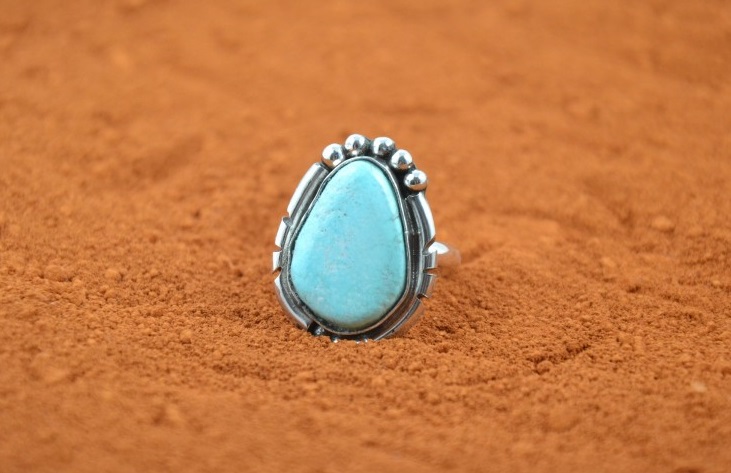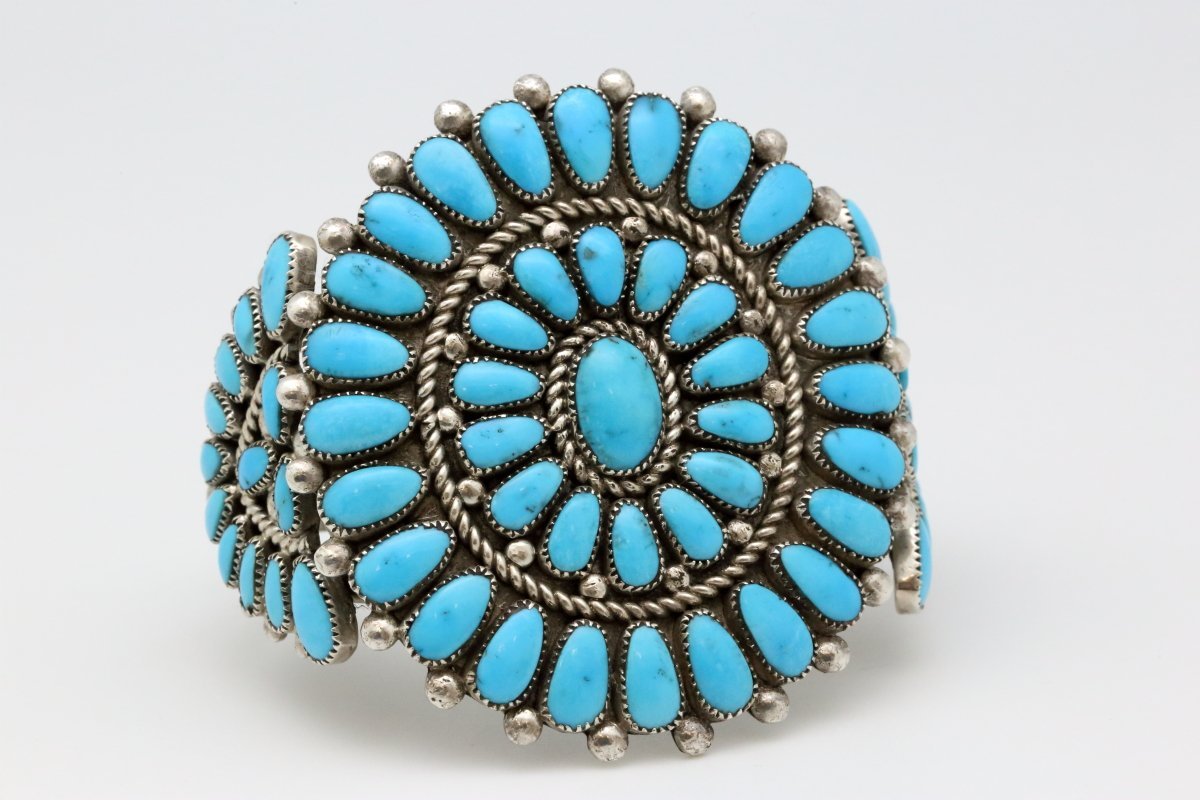The History of Native American Jewelry - Navajo-Hopi-Zuni Jewelry - Turquoise
When the Spanish and Mexicans recognized the Native Americans' dexterity in the 18th and early 19th centuries, they taught them how to work metal into bracelets, earrings, and other items. Soon after, the Native Americans began using Mexican silver pesos, and Native American jewelry began to flourish. They also began incorporating turquoise from their own region.
Turquoise and silver jewelry are worn and sold almost everywhere in the Southwest; you'll find them in roadside stalls, souvenir shops, art galleries, trading posts, pawn shops, and even flea markets. A Native American piece of jewelry should be examined closely, as turquoise varies from piece to piece, and often has symbols embedded in it. It's important to recognize the craftsman behind each piece, as it's a tradition in this region of the United States.
The first Navajo to learn ironwork around 1850 was Atsidi Sani, who persuaded a Mexican blacksmith to teach him the trade. Silverwork began a little later. The Navajo, Hopi, Zuni, and Pueblo used coins; American coins were used in jewelry around 1890. In 1930, when Mexican pesos were banned on American soil, silver bars replaced coins. In 1935, silver in sheets and wire was sold by Indian traders. Turquoise, a favorite stone of Southwestern Native Americans, was incorporated into silver jewelry in the 1880s. Between 1895 and 1900, Don Lorenzo Hubbell, who traded with the Indians, imported turquoise from Persia to trade with the Navajo. After 1900, the amount of turquoise mining increased in the Four Corners region, and the Indians turned to the local stone.
After their liberation from Bosque Redondo, many Navajos continued to work as blacksmiths, and many began making silver jewelry. By the mid-19th century, silver was being hammered by hand. Another pioneer in Navajo craftsmanship was Atsidi Chon, or "Ugly Smith." He was probably the first to make a silver horse bridle (1870). Atsidi Chon taught the method to the Zuni artisan Lanyade, and in 1880, Atsidi Chon or his apprentice, Peshlakai Atsidi, was the first to inlay turquoise into a piece of jewelry.
The squash blossom necklace and concho belt are considered the most typical form of Navajo craftsmanship, although other peoples have appropriated these jewelry. Other typical Navajo forms, made since the mid-18th century, are regularly worn by Navajo and non-Native people, such as silver buttons, bracelets, rings, earrings, and horse bridles. Newer forms have appeared, such as combs and barrettes, watch bands, bolo ties, keychains, and money clips.
In addition to turquoise and coral, other stones are added to color the jewelry, many of these stones are available locally, but others must be imported such as ivory, obsidian, onyx, sodalite, azurite, lapis lazuli, chrysocolla, malachite, and certain shells like abalone.
The first Zuni jewelry was neutral, without stones, and it was in 1890 that they began to include turquoise like their Navajo neighbors. A craftsman named Keneshde was the first Zuni to adorn jewelry with turquoise from the Cerrillos mines near Santa Fe, New Mexico. Around 1930, the Zuni made much of their jewelry for tourists, and 10 years later, it was a major source of income. The Zuni are primarily known for their stone marquetry techniques and needlepoint and petit point carvings. The carving of small fetishes, such as animals, birds, bears, etc., from turquoise, shell, coral, and jet, began in 1920 and was inspired by ancient pieces found at Hawikuh. The master fetish carver, Leekya Desyee, was among the workers who discovered the stone carvings.
The first Hopi jewelry was made of turquoise, shell, wood, and seeds. Silverwork on jewelry was introduced around 1890. The Zuni artisan Lanyade, after learning the craft from the Navajo, began trading among the Hopi Indians, and in 1890, Lanyade passed his skills on to a Hopi artisan named Sykiatala, or "Yellow Light." Initially, Hopi jewelry was indistinguishable from Navajo and Zuni jewelry; it was only around 1930 that a particular style called "overlay" emerged, which is today the most recognized technique in Hopi craftsmanship. In overlay, two sheets of silver are soldered together after cutting the top one into a design, so that the bottom one, which has been oxidized beforehand, is visible. The stones are only used occasionally by Hopi craftsmen.
People buy Native American jewelry for many reasons. Some simply enjoy wearing beautiful jewelry, while others are fascinated by Native American heritage and the traditions that jewelry represents. Then there are those who purchase high-quality jewelry that will be an investment. Each piece, handcrafted with quality materials, will always give its owner personal satisfaction.
Native American jewelry is usually made of silver, sometimes gold, copper, brass, or nickel, but most often it will be 925/1000 silver (92.5% silver and 7.5% copper) or 900/1000 (90% silver and 10% copper). A jeweler can chemically test the piece with nitric acid to verify the silver content.
It's difficult to tell a piece of handmade jewelry from one that's machine-made or mass-produced. Buyers should carefully examine the edges and back of a piece; if you see marks in these areas, it's a sign that it's been hand-forged and hammered. If the craftsman is good, the cabochons and stones should be well polished and finished. The stones in a handcrafted piece will be thicker and should fill the thickness of the setting.
Native American silver jewelry, like any other object or accessory, must be cleaned or sometimes repaired. The store where you purchased your jewelry often has a craftsman who can fix this. A few simple precautions can extend the life of a piece without resorting to a potentially costly repair. A bracelet with inlaid and glued stones should not be opened or twisted because the stones can come out of their place. Turquoise or other stones should not come into contact with grease, detergents, or other corrosive household products, otherwise the stone may change color. Each piece of jewelry should be placed separately in cotton, a handkerchief, or a piece of cloth when you are not wearing it. If all these precautions are taken, your beautiful Native American piece will last a very long time.


